A Proton-Coupled Transport System for β-Hydroxy-β-Methylbutyrate (HMB) in Blood–Brain Barrier Endothelial Cell Line hCMEC/D3
Abstract
:1. Introduction
2. Materials and Methods
2.1. Materials
2.2. Cell Lines and Culture Conditions
2.3. RT-PCR
2.4. siRNA Transfection
2.5. Uptake Measurements
2.6. Intracellular pH (pHin) Measurements
2.7. Western Blot
2.8. Statistics
3. Results
3.1. H+-Coupled HMB Transport in hCMEC/D3 Cells
3.2. Kinetics of HMB Uptake in hCMEC/D3 Cells
3.3. Non-Involvement of OATs and PAT1 (SLC36A1) in HMB Uptake in hCMEC/D3 Cells
3.4. Substrate Selectivity of the Transport System Responsible for HMB Uptake in hCMEC/D3 Cells
3.5. Relative Contribution of MCT1 and MCT4 to Total HMB Uptake in hCMEC/D3 Cells
3.6. Expression Profile of Lactate Transporters and Orphan Transporters in SLC16 Family in hCMEC/D3 Cells
3.7. Evidence for Coupled Transport of HMB and H+ in hCMEC/D3 Cells
3.8. Influence of HMB on the Expression of Selective Transporters in hCMEC/D3 Cells and Relevance of mTOR Signaling and HDAC Inhibition to the Process
4. Discussion
Author Contributions
Funding
Institutional Review Board Statement
Informed Consent Statement
Data Availability Statement
Conflicts of Interest
References
- Blair, M.C.; Neinast, M.D.; Arany, Z. Whole-body metabolic fate of branched-chain amino acids. Biochem. J. 2021, 478, 765–776. [Google Scholar] [CrossRef]
- Nie, C.; He, T.; Zhang, W.; Zhang, G.; Ma, X. Branched chain amino acids: Beyond nutrition metabolism. Int. J. Mol. Sci. 2018, 19, 954. [Google Scholar] [CrossRef] [PubMed] [Green Version]
- Le Couteur, D.G.; Solon-Biet, S.M.; Cogger, V.C.; Ribeiro, R.; de Cabo, R.; Raubenheimer, D.; Cooney, G.J.; Simpson, S.J. Branched chain amino acids, aging and age-related health. Ageing Res. Rev. 2020, 64, 101198. [Google Scholar] [CrossRef] [PubMed]
- Pimentel, G.D.; Rosa, J.C.; Lira, F.S.; Zanchi, N.E.; Ropelle, E.R.; Oyama, L.M.; Oller do Nascimento, C.M.; de Mello, M.T.; Tufik, S.; Santos, R.V.T. β-Hydroxy-β-methylbutyrate (HMβ) supplementation stimulates skeletal muscle hypertrophy in rats via the mTOR pathway. Nutr. Metab. (Lond.) 2011, 8, 11. [Google Scholar] [CrossRef] [PubMed] [Green Version]
- Kimura, K.; Cheng, X.W.; Inoue, A.; Hu, L.; Koike, T.; Kuzuya, M. β-Hydroxy-β-methylbutyrate facilitates PI3K/Akt-dependent mammalian target of rapamycin and FoxO1/3a phosphorylations and alleviates tumor necrosis factor α/interferon γ-induced MuRF-1 expression in C2C12 cells. Nutr. Res. 2014, 34, 368–374. [Google Scholar] [CrossRef]
- Kaczka, P.; Michalczyk, M.M.; Jastrzab, R.; Gawelczyk, M.; Kubicka, K. Mechanism of action and the effect of β-hydroxy-β-methylbutyrate (HMB) supplementation on different types of physical performance—A systematic review. J. Hum. Kinet. 2019, 68, 211–222. [Google Scholar] [CrossRef] [PubMed] [Green Version]
- Duan, Y.; Zhong, Y.; Xiao, H.; Zheng, C.; Song, B.; Wang, W.; Guo, Q.; Li, Y.; Han, H.; Gao, J.; et al. Gut microbiota mediates the protective effects of dietary β-Hydroxy-β-methylbutyrate (HMB) against obesity induced by high-fat diets. FASEB J. 2019, 33, 10019–10033. [Google Scholar] [CrossRef]
- Thangaraju, M.; Gopal, E.; Martin, P.M.; Ananth, S.; Smith, S.B.; Prasad, P.D.; Sterneck, E.; Ganapathy, V. SLC5A8 triggers tumor cell apoptosis through pyruvate-dependent inhibition of histone deacetylases. Cancer Res. 2006, 66, 11560–11564. [Google Scholar] [CrossRef] [PubMed] [Green Version]
- Singh, N.; Thangaraju, M.; Prasad, P.D.; Martin, P.M.; Lambert, N.A.; Boettger, T.; Offermanns, S.; Ganapathy, V. Blockade of dendritic cell development by bacterial fermentation products butyrate and propionate through a transporter (Slc5a8)-dependent inhibition of histone deacetylases. J. Biol. Chem. 2010, 285, 27601–27608. [Google Scholar] [CrossRef] [Green Version]
- Ganapathy, V.; Thangaraju, M.; Prasad, P.D.; Martin, P.M.; Singh, N. Transporters and receptors for short-chain fatty acids as the molecular link between colonic bacteria and the host. Curr. Opin. Pharmacol. 2013, 13, 869–874. [Google Scholar] [CrossRef] [PubMed]
- Sivaprakasam, S.; Bhutia, Y.D.; Ramachandran, S.; Ganapathy, V. Cell-surface and nuclear receptors in the colon as targets for bacterial metabolites and its relevance to colon health. Nutrients 2017, 9, 856. [Google Scholar] [CrossRef] [Green Version]
- Saito, R.; Vilchez, J.D.; Giron, M.D.; Cabrera, E.; Campos, N.; Manzano, M.; Rueda, R.; Lopez-Pedrosa, J.M. β-Hydroxy-β-methylbutyrate (HMB) promotes neurite outgrowth in Neuro2a cells. PLoS ONE 2015, 10, e0135614. [Google Scholar]
- Kougias, D.G.; Nolan, S.O.; Koss, W.A.; Kim, T.; Hankosky, E.R.; Gulley, J.M.; Juraska, J.M. β-Hydroxy-β-methylbutyrate ameliorates aging effects in the dendritic tree of pyramidal neurons in the medial prefrontal cortex of both male and female rats. Neurobiol. Aging 2016, 40, 78–85. [Google Scholar] [CrossRef] [PubMed]
- Kougias, D.G.; Hankosky, E.R.; Gulley, J.M.; Juraska, J.M. β-Hydroxy-β-methylbutyrate (HMB) ameliorates age-related deficits in water maze performance, especially in male rats. Physiol. Behav. 2017, 170, 93–99. [Google Scholar] [CrossRef] [PubMed]
- Ogura, J.; Sato, T.; Higuchi, K.; Bhutia, Y.D.; Babu, E.; Masuda, M.; Miyauchi, S.; Rueda, R.; Pereira, S.L.; Ganapathy, V. Transport mechanisms for the nutritional supplement β-hydroxy-β-methylbutyrate (HMB) in mammalian cells. Pharm. Res. 2019, 36, 84. [Google Scholar] [CrossRef] [PubMed]
- Felmlee, M.A.; Jones, R.S.; Rodriguez-Cruz, V.; Follman, K.E.; Morris, M.E. Monocarboxylate transporters (SLC16): Function, regulation, and role in health and disease. Pharmacol. Rev. 2020, 72, 466–485. [Google Scholar] [CrossRef]
- Halestrap, A.P. The SLC16 gene family—Structure, role and regulation in health and disease. Mol. Aspects Med. 2013, 34, 337–349. [Google Scholar] [CrossRef]
- Uchida, Y.; Ohtsuki, S.; Katsukura, Y.; Ikeda, C.; Suzuki, T.; Kamiie, J.; Terasaki, T. Quantitative targeted absolute proteomics of human blood–brain transporters and receptors. J. Neurochem. 2011, 117, 333–345. [Google Scholar] [CrossRef]
- Lauritzen, F.; Eid, T.; Bergersen, L.H. Monocarboxylate transporters in temporal lobe epilepsy: Roles of lactate and ketogenic diet. Brain Struct. Funct. 2015, 220, 1–12. [Google Scholar] [CrossRef] [PubMed]
- Perez-Escuredo, J.; Van Hee, V.F.; Sboarina, M.; Falces, J.; Payen, V.L.; Pellerin, L.; Sonveaux, P. Monocarboxylate transporters in the brain and in cancer. Biochim. Biophys. Acta 2016, 1863, 2481–2497. [Google Scholar] [CrossRef] [Green Version]
- Rojas, J.D.; Sennoune, S.R.; Maiti, D.; Bakunts, K.; Reuveni, M.; Sanka, S.C.; Martinez, G.M.; Seftor, E.A.; Meininger, C.J.; Wu, G.; et al. Vacuolar type H+-ATPases at the plasma membrane regulate pH and cell migration in microvascular endothelial cells. Am. J. Physiol. Heart Circ. Physiol. 2006, 291, H11478–H1157. [Google Scholar] [CrossRef] [Green Version]
- Nigam, S.K.; Bush, K.T.; Martovetsky, G.; Ahn, S.Y.; Liu, H.C.; Richard, E.; Bhatnagar, V.; Wu, W. The organic anion transporter (OAT) family: A systems biology perspective. Physiol. Rev. 2015, 95, 83–123. [Google Scholar] [CrossRef]
- Okamura, A.; Emoto, A.; Koyabu, N.; Ohtani, H.; Sawada, Y. Transport and uptake of nateglinide in Caco-2 cells and its inhibitory effect on human monocarboxylate transporter MCT1. Br. J. Pharmacol. 2002, 137, 391–399. [Google Scholar] [CrossRef]
- Chen, Z.; Fei, Y.J.; Anderson, C.M.H.; Wake, K.A.; Miyauchi, S.; Huang, W.; Thwaites, D.T.; Ganapathy, V. Structure, function and immunolocalization of a proton-coupled amino acid transporter (hPAT1) in the human intestinal cell line Caco-2. J. Physiol. 2003, 546, 349–361. [Google Scholar] [CrossRef] [PubMed]
- Thwaites, D.T.; Anderson, C.M.H. The SLC36 family of proton-coupled amino acid transporters and their potential role in drug transport. Br. J. Pharmacol. 2011, 164, 1802–1816. [Google Scholar] [CrossRef] [Green Version]
- Foltz, M.; Boll, M.; Raschka, L.; Kottra, G.; Daniel, H. A novel bifunctionality: PAT1 and PAT2 mediate electrogenic proton/amino acid and electroneutral proton/fatty acid symport. FASEB J. 2004, 18, 1758–1760. [Google Scholar] [CrossRef] [Green Version]
- Doherty, J.R.; Yang, C.; Scott, K.E.; Cameron, M.D.; Fallahi, M.; Li, W.; Hall, M.A.; Amelio, A.L.; Mishra, J.K.; Li, F.; et al. Blocking lactate export by inhibiting the Myc target MCT1 disables glycolysis and glutathione synthesis. Cancer Res. 2014, 74, 908–920. [Google Scholar] [CrossRef] [PubMed] [Green Version]
- Futagi, Y.; Kobayashi, M.; Narumi, K.; Furugen, A.; Iseki, K. Identification of a selective inhibitor of human monocarboxylate transporter 4. Biochem. Biophys. Res. Commun. 2018, 495, 427–432. [Google Scholar] [CrossRef] [Green Version]
- Yoon, H.; Fanelli, A.; Grollman, E.F.; Philp, N.J. Identification of a unique monocarboxylate transporter (MCT3) in retinal pigment epithelium. Biochem. Biophys. Res. Commun. 1997, 234, 90–94. [Google Scholar] [CrossRef] [PubMed]
- Hugo, S.E.; Cruz-Garcia, L.; Karanth, S.; Anderson, R.M.; Stainier, D.Y.; Schlegel, A. A monocarboxylate transporter required for hepatocyte secretion of ketone bodies during fasting. Genes Dev. 2012, 26, 282–293. [Google Scholar] [CrossRef] [PubMed] [Green Version]
- Venkateswaran, N.; Lafita-Navarro, M.C.; Hao, Y.H.; Kilgore, J.A.; Perez-Castro, L.; Braverman, J.; Borenstein-Auerbach, N.; Kim, M.; Lesner, N.P.; Mishra, P.; et al. MYC promotes tryptophan uptake and metabolism by the kynurenine pathway in colon cancer. Genes Dev. 2019, 33, 1236–1251. [Google Scholar] [CrossRef] [Green Version]
- Singh, N.; Ecker, G.F. Insights into the structure, function, and ligand discovery of the large neutral amino acid transporter 1, LAT1. Int. J. Mol. Sci. 2018, 19, 1278. [Google Scholar] [CrossRef] [Green Version]
- Tarlungeanu, D.C.; Deliu, E.; Dotter, C.P.; Kara, M.; Janiesch, P.C.; Scalise, M.; Galluccio, M.; Tesulov, M.; Schlessinger, A.; Indiveri, C.; et al. Impaired amino acid transport at the blood brain barrier is a cause of autism spectrum disorder. Cell 2016, 167, 1481–1494. [Google Scholar] [CrossRef] [Green Version]
- Cascio, L.; Chen, C.F.; Pauly, R.; Srikanth, S.; Jones, K.; Skinner, C.D.; Stevenson, R.E.; Schwartz, C.E.; Boccuto, L. Abnormalities in the genes that encode large amino acid transporters increase the risk of autism spectrum disorder. Mol. Genet. Genomic Med. 2020, 8, e1036. [Google Scholar] [CrossRef] [PubMed] [Green Version]
- Sivaprakasam, S.; Bhutia, Y.D.; Yang, S.; Ganapathy, V. Short-chain fatty acid transporters: Role in colonic homeostasis. Compr. Physiol. 2017, 8, 299–314. [Google Scholar]
- Weksler, B.B.; Subileau, E.A.; Perriere, N.; Charneau, P.; Holloway, K.; Leveque, M.; Tricoire-Leignel, H.; Nicotra, A.; Bourdoulous, S.; Turowski, P.; et al. Blood–brain barrier-specific properties of a human adult brain endothelial cell line. FASEB J. 2005, 19, 1872–1874. [Google Scholar] [CrossRef] [PubMed]
- Helms, H.C.; Abbott, N.J.; Burek, M.; Cecchelli, R.; Couraud, P.O.; Deli, M.A.; Forster, C.; Galla, H.J.; Romero, I.A.; Shusta, E.V.; et al. In vitro models of the blood–brain barrier: An overview of commonly used brain endothelial cell culture models and guidelines for their use. J. Cereb. Blood Flow Metab. 2016, 36, 862–890. [Google Scholar] [CrossRef]
- Ohtsuki, S.; Ikeda, C.; Uchida, Y.; Sakamoto, Y.; Miller, F.; Glacial, F.; Decleves, X.; Scherrmann, J.M.; Couraud, P.O.; Kubo, Y.; et al. Quantitative targeted absolute proteomic analysis of transporters, receptors and junction proteins for validation of human cerebral microvascular endothelial cell line hCMEC/D3 as a human blood–brain barrier model. Mol. Pharm. 2013, 10, 289–296. [Google Scholar] [CrossRef] [PubMed]
- Pierre, K.; Pellerin, L. Monocarboxylate transporters in the central nervous system: Distribution, regulation and function. J. Neurochem. 2005, 94, 1–14. [Google Scholar] [CrossRef]
- Bergersen, L.H. Lactate transport and signaling in the brain: Potential therapeutic targets and roles in body-brain interaction. J. Cereb. Blood Flow Metab. 2015, 35, 176–185. [Google Scholar] [CrossRef] [Green Version]
- Contreras-Baeza, Y.; Sandoval, P.Y.; Alarcon, R.; Galaz, A.; Cortes-Molina, F.; Alegria, K.; Baeza-Lehnert, F.; Arce-Molina, R.; Guequén, A.; Flores, C.A.; et al. Monocarboxylate transporter 4 (MCT4) is a high affinity transporter capable of exporting lactate in high-lactate microenvironments. J. Biol. Chem. 2019, 294, 20135–20147. [Google Scholar] [CrossRef]
- Roberts, L.M.; Black, D.S.; Raman, C.; Woodford, K.; Zhou, M.; Haggerty, J.E.; Yan, A.T.; Cwirla, S.E.; Grindstaff, K.K. Subcellular localization of transporters along the rat blood–brain barrier and blood-cerebral-spinal fluid barrier by in vivo biotinylation. Neuroscience 2008, 155, 423–438. [Google Scholar] [CrossRef] [PubMed]
- Huang, C.K.; Chang, P.H.; Kuo, W.H.; Chen, C.L.; Jeng, Y.M.; Chang, K.J.; Shew, J.Y.; Hu, C.M.; Lee, W.H. Adipocytes promote malignant growth of breast tumours with monocarboxylate transporter 2 expression via β-hydroxybutyrate. Nat. Commun. 2017, 8, 14706. [Google Scholar] [CrossRef] [PubMed]
- Goncalves, P.; Gregorio, I.; Martel, F. The short-chain fatty acid butyrate is a substrate of breast cancer resistance protein. Am. J. Physiol. Cell Physiol. 2011, 301, C984–C994. [Google Scholar] [CrossRef] [PubMed] [Green Version]

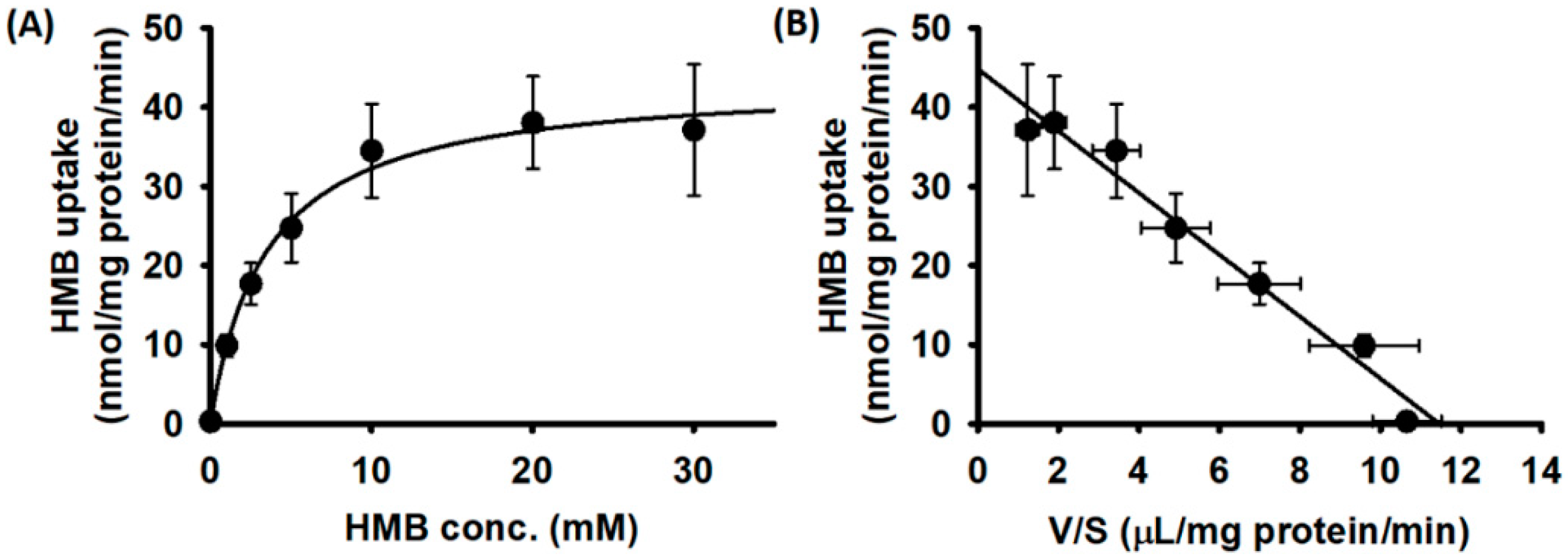
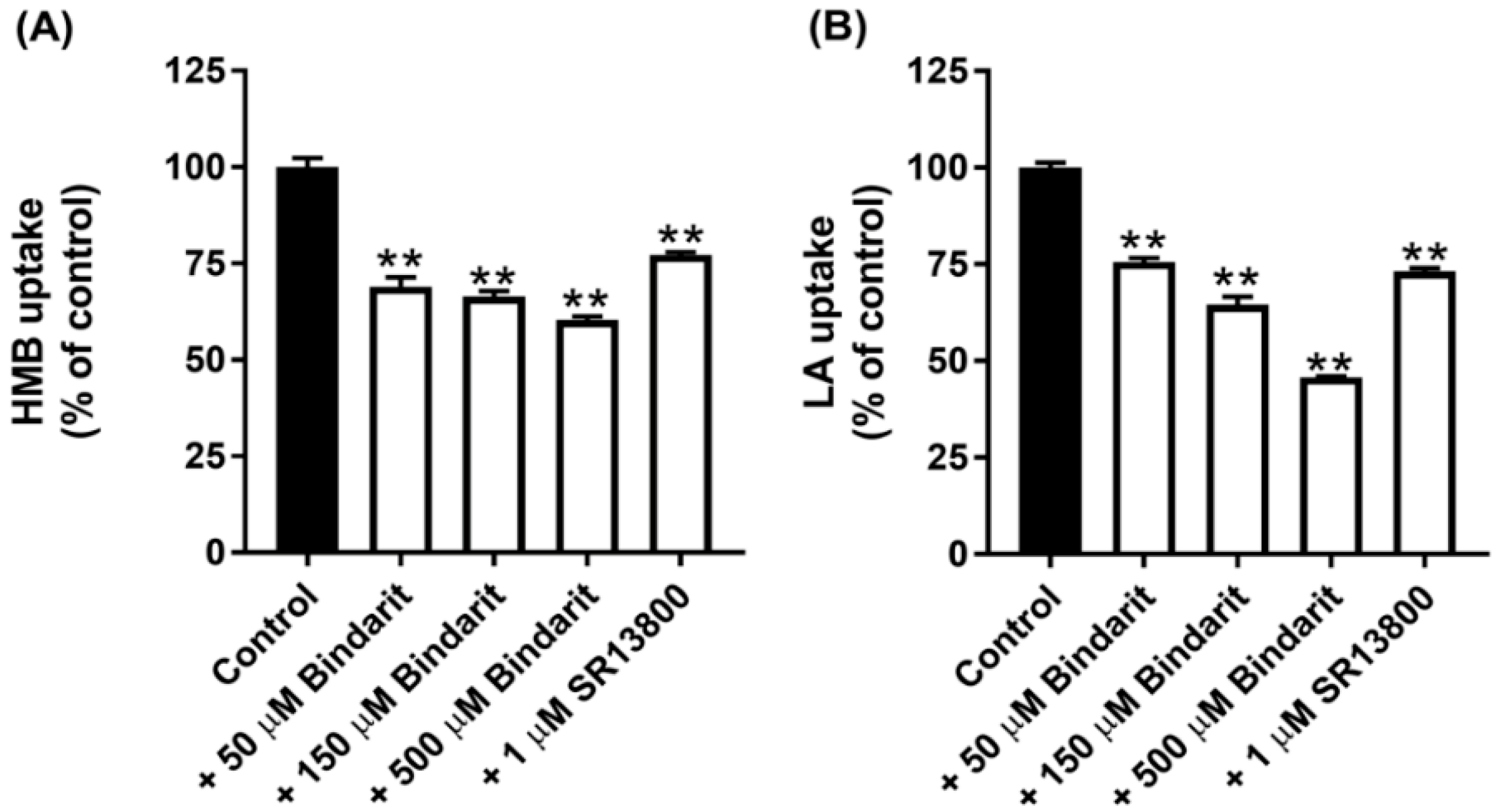

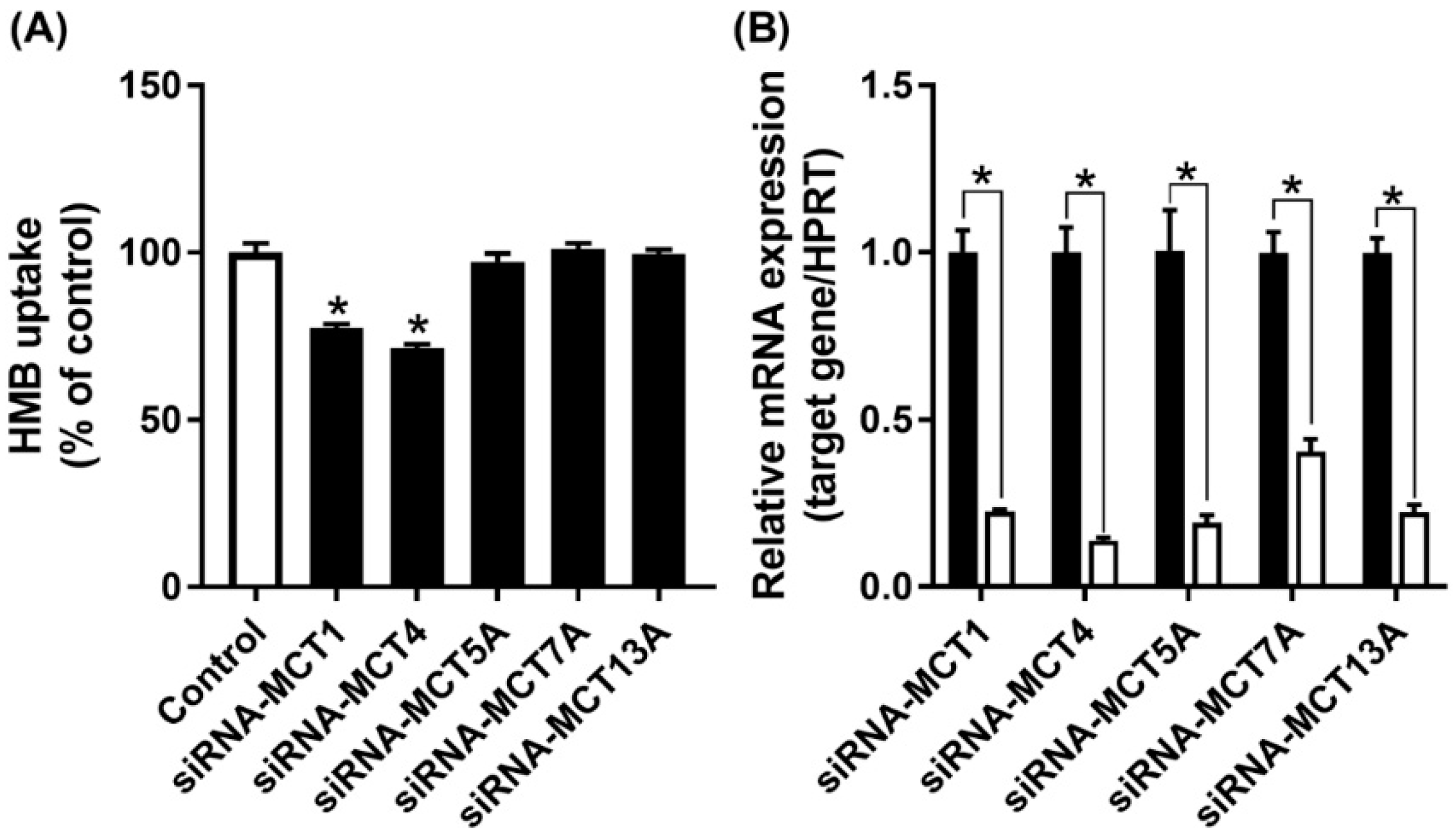
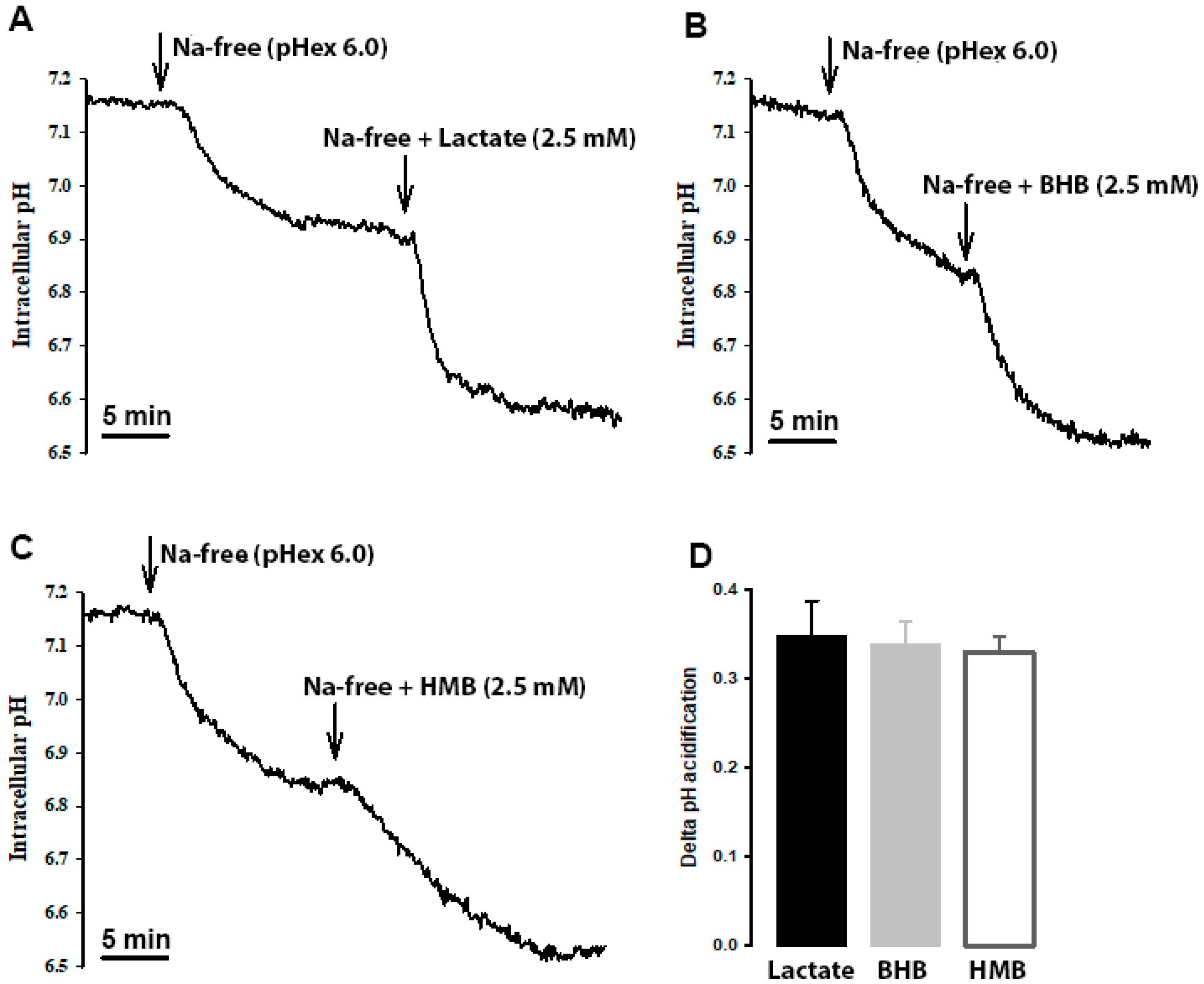
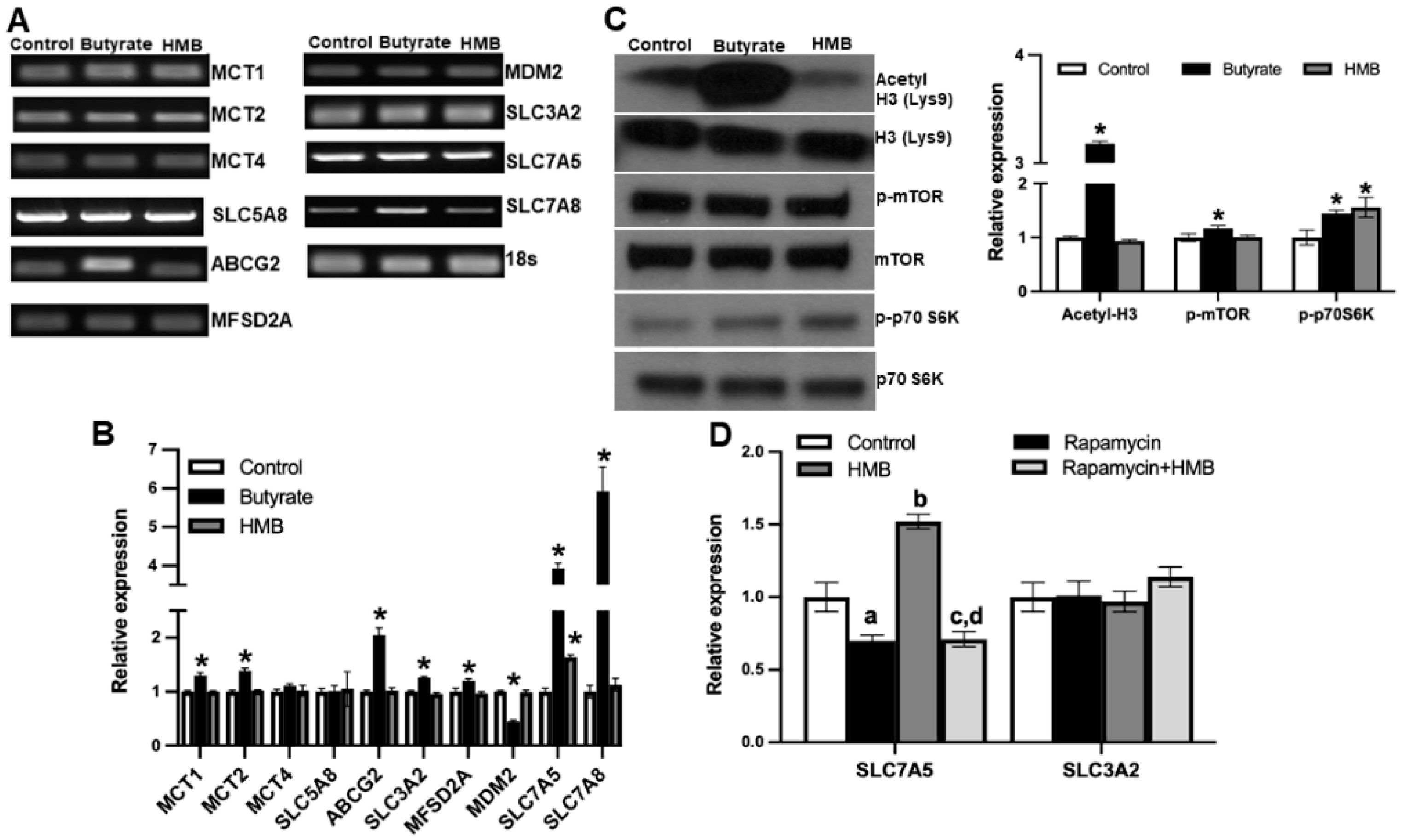
| Species | Protein Name | Gene Name | Orientation | Sequence |
|---|---|---|---|---|
| Human | MCT1 | SLC16A1 | Forward | GGTGGAGGTCCTATCAGCAG |
| Reverse | TCAAGTTGAAGGCAAGCCCA | |||
| MCT4 | SLC16A3 | Forward | ATCCTGGGCTTCATTGACAT | |
| Reverse | CTTCAGGAAATGCTCCACCT | |||
| SMCT1 | SLC5A8 | Forward | CGTCTCTGTGGAACAGTCCT | |
| Reverse | TAAGACCACCCAGTGTGCAG | |||
| MCT5 | SLC16A4 | Forward | TCTACCCGGTTTGGGTTCTG | |
| Reverse | GGGCTCCTGTCCAGTCATAC | |||
| MCT6 | SLC16A5 | Forward | CCTGAGATCATGTGCCAGTCT | |
| Reverse | TAGGGCTATTCCAGCCCAGA | |||
| MCT7 | SLC16A6 | Forward | GGCATCATCTCTGGTCTGGG | |
| Reverse | TGGTGCGAAAGCAAACACAG | |||
| MCT9 | SLC16A9 | Forward | CACCCATCGTTGGTTGGTTT | |
| Reverse | CTTGGGGAGTTGCTTGTTGC | |||
| MCT11 | SLC16A11 | Forward | GGTTTTCGGTGTACTCCCCG | |
| Reverse | CTTAGGAAGCCTGACAGGGG | |||
| MCT12 | SLC16A12 | Forward | ACGGGCAGTCACAAGATGTAT | |
| Reverse | CAACACTCCCAAGTGGAGCA | |||
| MCT13 | SLC16A13 | Forward | CAGTTTGGGAGCCCGGTAGG | |
| Reverse | GAGCCTGACAGCAACCCAAT | |||
| MCT14 | SLC16A14 | Forward | GATAGTGGGCCCTTTCATCG | |
| Reverse | CGTTTGCAGCATAGGCACTC | |||
| LAT1 | SLC7A5 | Forward | CCGTGCCGTCCCTCGTGTTC | |
| Reverse | GGTTCACCTTGATGGGCCGCT | |||
| LAT2 | SLC7A8 | Forward | CAGAGTCTGGCCTTCGGCTC | |
| Reverse | CCAGCCAGAAGTACTCTCCTTTG | |||
| 4F2HC | SLC3A2 | Forward | CTCGTGGTTCTCCACTCAGG | |
| Reverse | CCG CAATCAAGAGCCTGTCT | |||
| ABCG2 | Forward | TCAGATGGGTTTCCAAGCGT | ||
| Reverse | AACCCCAGCTCTGTTCTGGA | |||
| MFSD2A | Forward | CTCCTGGCCATCATGCTCTC | ||
| Reverse | GGCCACCAAGATGAGAAA | |||
| MDM2 | Forward | AGGAGATTTGTTTGGCGTGC | ||
| Reverse | TGAGTCCGATGATTCCTGCTG | |||
| 18S | Forward | CCCGTTGAACCCCATTCGT | ||
| Reverse | GCCTCACTAAACCATCCAATCGGTA | |||
| Mouse | Mct5 | Slc16a4 | Forward | ACTCCGTTTCTCTGCAGGTC |
| Reverse | AGATCCCAAACCAGGTAGCA | |||
| Mct6 | Slc16a5 | Forward | TCGTGGTTTCCTTCCATCCTG | |
| Reverse | CCCAGGCCTGTGATCACTCC | |||
| Mct7 | Slc16a6 | Forward | GGGGTAATCTCGGGTTTAGGG | |
| Reverse | TGATAGCTGGTGCGAAAGCA | |||
| Mct9 | Slc16a9 | Forward | GAGCAGTCTTGCCCCCAATA | |
| Reverse | ACCCACACTCGAACCTGTTG | |||
| Mct11 | Slc16a11 | Forward | TATGCCCCACTGGTTTTCGG | |
| Reverse | TAGGAAGCCTGACAGAGGAGG | |||
| Mct12 | Slc16a12 | Forward | CGGGCAGTCACCAGATGTA | |
| Reverse | ACTGACAACACTCCCAAGCG | |||
| Mct13 | Slc16a13 | Forward | GTTTGGGAGCCCAATAGGCAG | |
| Reverse | CCTGACAGCAGCCCAATACT | |||
| Mct14 | Slc16a14 | Forward | TGATCGTGGGACCTTTCATCG | |
| Reverse | GCAGGTAGGTAAGCCATCCC | |||
| Human/Mouse | HPRT | Forward | GCGTCGTGATTAGCGATGATGAAC | |
| Reverse | CCTCCCATCTCCTTCATGACATCT |
| Inhibitor | HMB Uptake (% of Control) |
|---|---|
| Control | 100 ± 2 |
| 1 mM PAH | 103 ± 4 |
| 5 mM Glycine | 92.6 ± 4.2 |
| 5 mM Proline | 90.1 ± 6.2 * |
| 5 mM Leucine | 81.4 ± 5.2 ** |
| Control (+20 mM Sodium chloride) | 100 ± 2 |
| 20 mM Lactate | 28.4 ± 0.3 ** |
| 20 mM Pyruvate | 23.2 ± 1.5 ** |
| 20 mM Acetate | 29.1 ± 1.1 ** |
| 20 mM Propionate | 26.7 ± 1.0 ** |
| 20 mM Butyrate | 25.5 ± 0.5 ** |
| 20 mM β-Hydroxybutyrate | 22.2 ± 0.9 ** |
| 20 mM Nicotinate | 27.5 ± 2.8 |
| Control (+0.5% DMSO) | 100 ± 2 |
| 1 mM Probenecid | 45.0 ± 3.3 ** |
Publisher’s Note: MDPI stays neutral with regard to jurisdictional claims in published maps and institutional affiliations. |
© 2021 by the authors. Licensee MDPI, Basel, Switzerland. This article is an open access article distributed under the terms and conditions of the Creative Commons Attribution (CC BY) license (https://creativecommons.org/licenses/by/4.0/).
Share and Cite
Higuchi, K.; Sivaprakasam, S.; Sennoune, S.R.; Ogura, J.; Bhutia, Y.D.; Rueda, R.; Pereira, S.L.; Ganapathy, V. A Proton-Coupled Transport System for β-Hydroxy-β-Methylbutyrate (HMB) in Blood–Brain Barrier Endothelial Cell Line hCMEC/D3. Nutrients 2021, 13, 3220. https://doi.org/10.3390/nu13093220
Higuchi K, Sivaprakasam S, Sennoune SR, Ogura J, Bhutia YD, Rueda R, Pereira SL, Ganapathy V. A Proton-Coupled Transport System for β-Hydroxy-β-Methylbutyrate (HMB) in Blood–Brain Barrier Endothelial Cell Line hCMEC/D3. Nutrients. 2021; 13(9):3220. https://doi.org/10.3390/nu13093220
Chicago/Turabian StyleHiguchi, Kei, Sathish Sivaprakasam, Souad R. Sennoune, Jiro Ogura, Yangzom D. Bhutia, Ricardo Rueda, Suzette L. Pereira, and Vadivel Ganapathy. 2021. "A Proton-Coupled Transport System for β-Hydroxy-β-Methylbutyrate (HMB) in Blood–Brain Barrier Endothelial Cell Line hCMEC/D3" Nutrients 13, no. 9: 3220. https://doi.org/10.3390/nu13093220






